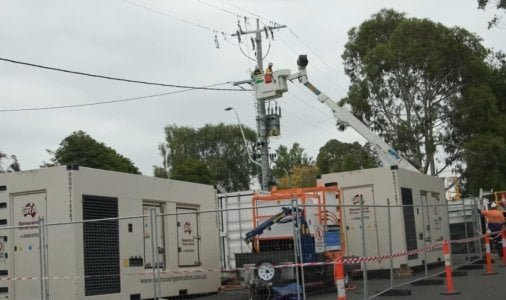Town’s connectivity crisis sparks debate over modernising Australia's telecommunications obligations
- Replies 19
In the age of constant connectivity, where smartphones are seemingly extensions of ourselves, it's hard to imagine being cut off from the world.
Yet reliable phone coverage remains a significant issue for many Australians, particularly those in rural and regional areas.
In a move that could have significant implications for residents across Australia, recent discussions have emerged concerning the funding and maintenance of a crucial service.
The outcome of this review is expected to impact the availability and quality of an essential communication tool, sparking widespread debate and interest among various stakeholders.
The story of Mirboo North, a town about a two-hour drive east of Melbourne, brings this issue into sharp focus.
After a ‘super-cell’ storm wreaked havoc, the town was left without power, phone, and internet services for days, highlighting a critical gap in Australia's telecommunications infrastructure.
‘It was absolutely terrifying,’ Mirboo North resident Ruth Rogan recalled, saying the town felt isolated in the time of need.
‘Not having that communication, not knowing whether your family was all okay, if resources were on their way to assist.’

For the next two days, Mirboo North residents were left without power or telecommunication services.
They were unable to contact the state's emergency services to report that powerlines were dangerously hanging from poles, roofs had been ripped off buildings, and dozens of homes were so severely damaged that they would later be deemed uninhabitable.
Residents were finally able to use their phones to contact each other and the outside world only after the South Gippsland Shire brought a generator and a Starlink satellite to the town.
Ms Rogan noted that this ‘slowed up the response’ and has prompted questions about the obligations that Australian telecommunications companies should have.
‘The way the emergency services work is that they don't know what has happened unless we tell them,’ she explained.
‘And if we don't have the ability to communicate the extent of the damage and what's needed, the response just doesn't start.’
Over a million Victorians experienced power outages during the severe February storm. Although most had their electricity back within 72 hours, some areas like Mirboo North faced a 10-day wait.
Ms Rogan was among the last to be reconnected and to have her NBN service restored, enabling her to resume making voice calls on her mobile phone.
The incident in Mirboo North is a stark reminder of the limitations of the current Universal Service Obligation (USO).
The USO ensures all Australians have access to voice calls via ‘standard telephone services (landlines) and payphones’, regardless of where they live and work, but it does not extend to mobile services.
This policy, which may seem outdated in a digital age where mobile phones are ubiquitous, could be holding us back from better phone coverage.
Telstra, the country's largest telco, is paid roughly $270 million annually to maintain the aging copper network for landlines and operate thousands of payphones across Australia.
While these services are crucial, especially in emergencies, the reality is that mobile phones have become the primary means of communication for most Australians.
In the digital era, where 97 per cent of households have NBN access and 99.6 per cent of Australians are served by at least one mobile network, the government is questioning if a fixed-line phone service remains a basic expectation for Australians.
The USO's focus on landlines does not reflect this shift, leaving a gap in guaranteed mobile service coverage.
In 2017, the Productivity Commission criticised the USO as ‘anachronistic and costly’, and the Telecommunications Industry Ombudsman, Cynthia Gebert, agrees that it's time for an update.
‘[The USO] is a really important consumer protection, but it is around having a fixed-line telephone service that works when you need it to work,’ she stated.
‘And I think most Australians would be surprised to learn that that is the only telephone service that is guaranteed by [the] government, and fewer and fewer people are using it.’
Despite Australians' heavy reliance on mobile phones, they are not classified as essential services, and there are no regulations ensuring minimum mobile coverage or service quality.
Ms Gebert suggested updating the Universal Service Obligation (USO) to include access to voice services through a combination of landlines, payphones, mobile phones, fibre and fixed wireless NBN, and low Earth orbit satellites like Starlink.
This update would require the telco holding the USO contract (currently Telstra) to address service failures more promptly and grant the ombudsman authority to mandate improvements in coverage quality and address gaps.
‘What we're asking the government to do is create a more modern, contemporary regulatory environment that has technology-neutral service standards for both landline and internet, to ensure that consumers can get connected to a usable, reliable and quality service,’ Ms Gebert explained.
Telstra itself is advocating for change, proposing to redirect funds from maintaining the copper network to investing in more modern technologies that could provide a better customer experience.
‘This means removing the requirement for Telstra to use the outdated copper network to deliver USO telephone services in much of regional and remote Australia,’ the company said in a statement.
‘Instead, newer and more reliable technology such as wireless or satellite could be used in those areas for a better customer experience.’
However, the telco cautioned that relying solely on mobile phones for universal coverage under the Universal Service Obligation is ‘just not technically or financially feasible’ in a country as vast as Australia.
The Victorian government's review of the February storm that affected Mirboo North concluded that ‘losing phone services was worse than being without power’ for many communities.
It urged the federal government to make telecommunications services more resilient, suggesting several changes, including requiring telecommunications companies to ensure their phone towers can operate for three days without mains power (rather than just three hours, as seen in Mirboo North).
It also recommended implementing temporary disaster roaming, which would enable Australians to make calls using any available network during large-scale outages.
In response to these challenges, communities like Mirboo North are taking proactive steps, such as using grants to install solar panels, batteries, and satellite systems to ensure connectivity during power outages.
However, residents like Ruth Rogan are calling for legislative changes at the federal level to prevent such isolation in future crises.
‘It is just so isolating when you haven't the ability to communicate your needs in a crisis,’ she said.
As the conversation around telecommunications evolves, the focus is not only on ensuring reliable services during emergencies but also on addressing ongoing coverage concerns.
While recent reviews highlight the need for improved resilience and temporary disaster solutions, regional residents are voicing their apprehensions about the upcoming 3G network shutdown.
This transition could impact those relying on 4G coverage, raising further questions about the future of connectivity in less populated areas.
 Have you faced similar issues to those in Mirboo North? What changes would you like to see to ensure reliable communication across Australia?
Have you faced similar issues to those in Mirboo North? What changes would you like to see to ensure reliable communication across Australia?
We invite you to share your experiences with phone coverage, especially in times of emergency.
Your stories and opinions are valuable as we navigate the complexities of modern telecommunications and advocate for policies that serve everyone.
Yet reliable phone coverage remains a significant issue for many Australians, particularly those in rural and regional areas.
In a move that could have significant implications for residents across Australia, recent discussions have emerged concerning the funding and maintenance of a crucial service.
The outcome of this review is expected to impact the availability and quality of an essential communication tool, sparking widespread debate and interest among various stakeholders.
The story of Mirboo North, a town about a two-hour drive east of Melbourne, brings this issue into sharp focus.
After a ‘super-cell’ storm wreaked havoc, the town was left without power, phone, and internet services for days, highlighting a critical gap in Australia's telecommunications infrastructure.
‘It was absolutely terrifying,’ Mirboo North resident Ruth Rogan recalled, saying the town felt isolated in the time of need.
‘Not having that communication, not knowing whether your family was all okay, if resources were on their way to assist.’

After a severe storm, Mirboo North faced a significant loss of mobile and telecommunication services, raising concerns about current service obligations. Credit: 9 News Melbourne
For the next two days, Mirboo North residents were left without power or telecommunication services.
They were unable to contact the state's emergency services to report that powerlines were dangerously hanging from poles, roofs had been ripped off buildings, and dozens of homes were so severely damaged that they would later be deemed uninhabitable.
Residents were finally able to use their phones to contact each other and the outside world only after the South Gippsland Shire brought a generator and a Starlink satellite to the town.
Ms Rogan noted that this ‘slowed up the response’ and has prompted questions about the obligations that Australian telecommunications companies should have.
‘The way the emergency services work is that they don't know what has happened unless we tell them,’ she explained.
‘And if we don't have the ability to communicate the extent of the damage and what's needed, the response just doesn't start.’
Over a million Victorians experienced power outages during the severe February storm. Although most had their electricity back within 72 hours, some areas like Mirboo North faced a 10-day wait.
Ms Rogan was among the last to be reconnected and to have her NBN service restored, enabling her to resume making voice calls on her mobile phone.
The incident in Mirboo North is a stark reminder of the limitations of the current Universal Service Obligation (USO).
The USO ensures all Australians have access to voice calls via ‘standard telephone services (landlines) and payphones’, regardless of where they live and work, but it does not extend to mobile services.
This policy, which may seem outdated in a digital age where mobile phones are ubiquitous, could be holding us back from better phone coverage.
Telstra, the country's largest telco, is paid roughly $270 million annually to maintain the aging copper network for landlines and operate thousands of payphones across Australia.
While these services are crucial, especially in emergencies, the reality is that mobile phones have become the primary means of communication for most Australians.
In the digital era, where 97 per cent of households have NBN access and 99.6 per cent of Australians are served by at least one mobile network, the government is questioning if a fixed-line phone service remains a basic expectation for Australians.
The USO's focus on landlines does not reflect this shift, leaving a gap in guaranteed mobile service coverage.
In 2017, the Productivity Commission criticised the USO as ‘anachronistic and costly’, and the Telecommunications Industry Ombudsman, Cynthia Gebert, agrees that it's time for an update.
‘[The USO] is a really important consumer protection, but it is around having a fixed-line telephone service that works when you need it to work,’ she stated.
‘And I think most Australians would be surprised to learn that that is the only telephone service that is guaranteed by [the] government, and fewer and fewer people are using it.’
Despite Australians' heavy reliance on mobile phones, they are not classified as essential services, and there are no regulations ensuring minimum mobile coverage or service quality.
Ms Gebert suggested updating the Universal Service Obligation (USO) to include access to voice services through a combination of landlines, payphones, mobile phones, fibre and fixed wireless NBN, and low Earth orbit satellites like Starlink.
This update would require the telco holding the USO contract (currently Telstra) to address service failures more promptly and grant the ombudsman authority to mandate improvements in coverage quality and address gaps.
‘What we're asking the government to do is create a more modern, contemporary regulatory environment that has technology-neutral service standards for both landline and internet, to ensure that consumers can get connected to a usable, reliable and quality service,’ Ms Gebert explained.
Telstra itself is advocating for change, proposing to redirect funds from maintaining the copper network to investing in more modern technologies that could provide a better customer experience.
‘This means removing the requirement for Telstra to use the outdated copper network to deliver USO telephone services in much of regional and remote Australia,’ the company said in a statement.
‘Instead, newer and more reliable technology such as wireless or satellite could be used in those areas for a better customer experience.’
However, the telco cautioned that relying solely on mobile phones for universal coverage under the Universal Service Obligation is ‘just not technically or financially feasible’ in a country as vast as Australia.
The Victorian government's review of the February storm that affected Mirboo North concluded that ‘losing phone services was worse than being without power’ for many communities.
It urged the federal government to make telecommunications services more resilient, suggesting several changes, including requiring telecommunications companies to ensure their phone towers can operate for three days without mains power (rather than just three hours, as seen in Mirboo North).
It also recommended implementing temporary disaster roaming, which would enable Australians to make calls using any available network during large-scale outages.
In response to these challenges, communities like Mirboo North are taking proactive steps, such as using grants to install solar panels, batteries, and satellite systems to ensure connectivity during power outages.
However, residents like Ruth Rogan are calling for legislative changes at the federal level to prevent such isolation in future crises.
‘It is just so isolating when you haven't the ability to communicate your needs in a crisis,’ she said.
As the conversation around telecommunications evolves, the focus is not only on ensuring reliable services during emergencies but also on addressing ongoing coverage concerns.
While recent reviews highlight the need for improved resilience and temporary disaster solutions, regional residents are voicing their apprehensions about the upcoming 3G network shutdown.
This transition could impact those relying on 4G coverage, raising further questions about the future of connectivity in less populated areas.
Key Takeaways
- The town of Mirboo North experienced a lack of mobile and telecommunication services following a severe storm, highlighting concerns over current service obligations.
- Current legislation obligates Telstra to maintain landlines and payphones, but there are no equivalent obligations for mobile services.
- The Telecommunications Industry Ombudsman suggested updating the Universal Service Obligation to include a variety of technologies for voice services.
- Recommendations from a Victorian government review stressed the need for telcos to ensure longer-lasting backup power for phone towers and the introduction of temporary disaster roaming.
We invite you to share your experiences with phone coverage, especially in times of emergency.
Your stories and opinions are valuable as we navigate the complexities of modern telecommunications and advocate for policies that serve everyone.







